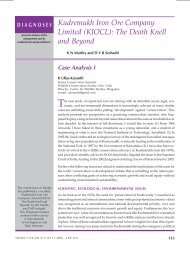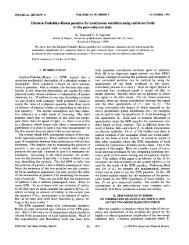Phase Transfer Catalysis - Publications of the IAS Fellows
Phase Transfer Catalysis - Publications of the IAS Fellows
Phase Transfer Catalysis - Publications of the IAS Fellows
You also want an ePaper? Increase the reach of your titles
YUMPU automatically turns print PDFs into web optimized ePapers that Google loves.
MY S<br />
1 Fast<br />
-7<br />
!T Fast<br />
Model A<br />
Mxs<br />
t Fast<br />
- M X : Ion exchange is<br />
in equilibrium<br />
Model B<br />
: Occurs in<br />
<strong>the</strong> bulk<br />
MxS<br />
t Fast<br />
+<br />
*<br />
- MX org + Q+Y-0l.g : Occurs in<br />
<strong>the</strong> bulk<br />
Model C<br />
RY org + Q+X- org<br />
MxS<br />
Fast<br />
kl<br />
+ Q+X-org - MX*o + Q+Y-o<br />
k-l<br />
: Occurs in<br />
<strong>the</strong> bulk<br />
: Occurs in<br />
<strong>the</strong> bulk<br />
/1 Q+Y-org + RXorg k2 l RYorg + Q+X- : Occurs in<br />
/<br />
Model D<br />
film, 6<br />
/*<br />
/ i$ . My*<br />
MxS<br />
/._-- (w2<br />
i Fast<br />
kl<br />
--iivf + Q+X-org- MX *<br />
erg + Q”k-l<br />
or g<br />
k2<br />
Q+Y-org + RXorg - RY org + Q+X- org<br />
><br />
MYI=<br />
decrease in <strong>the</strong> reaction rate, and hence in <strong>the</strong> conversion.<br />
Tbus, an assumption <strong>of</strong> constant QY and pseudo-first-order<br />
reaction rate can lead to a gross overestimate <strong>of</strong> <strong>the</strong> expected<br />
conversion. Figure lob shows that <strong>the</strong> quat concentration is<br />
not constant (as in usually assumed), but gradually builds up<br />
from zero to unity as time increases.<br />
A comprehensive model for heterogeneous solubilization<br />
was also developed by Naik and Doraiswamy (1997), which<br />
accounts for ion exchange in <strong>the</strong> solid phase, interphase<br />
transport <strong>of</strong> <strong>the</strong> quat species, and <strong>the</strong> organic reaction. In<br />
this case, ion exchange taking place in <strong>the</strong> solid phase can be<br />
one <strong>of</strong> <strong>the</strong> rate controlling steps, since access to <strong>the</strong> anions in<br />
org <strong>the</strong> bulk<br />
Figure 9. Models for homogeneous solubilization.<br />
Adapted from Naik and Doraiswamy (1997).<br />
: occur!3<br />
in <strong>the</strong> film<br />
: Occurs in <strong>the</strong><br />
fil~ulk;<br />
depending<br />
on <strong>the</strong> regime<br />
<strong>the</strong> solid can be restricted by mechanical hindrances due to<br />
<strong>the</strong> lattice structure and <strong>the</strong> deposition <strong>of</strong> <strong>the</strong> product MX.<br />
For a reactive solid, transient conditions prevail within <strong>the</strong><br />
solid and <strong>the</strong> controlling regime can continually shift with<br />
time. Structural changes within <strong>the</strong> solid with reaction can<br />
also affect <strong>the</strong> rates <strong>of</strong> <strong>the</strong> individual steps. In <strong>the</strong> general<br />
case, <strong>the</strong> controlling steps can ei<strong>the</strong>r be <strong>the</strong> liquid-phase<br />
transfer steps (external mass transfer), <strong>the</strong> diffusion steps with<br />
<strong>the</strong> reactive solid, <strong>the</strong> adsorption-desorption steps (if any),<br />
<strong>the</strong> surface (ion-exchange) reaction, or <strong>the</strong> liquid-phase organic<br />
reaction. Depending on <strong>the</strong> porosity <strong>of</strong> <strong>the</strong> solid and<br />
o<strong>the</strong>r factors, different models can be chosen for <strong>the</strong> ion-ex-<br />
626 March 1998 Vol. 44, No. 3 AIChE Journal
















